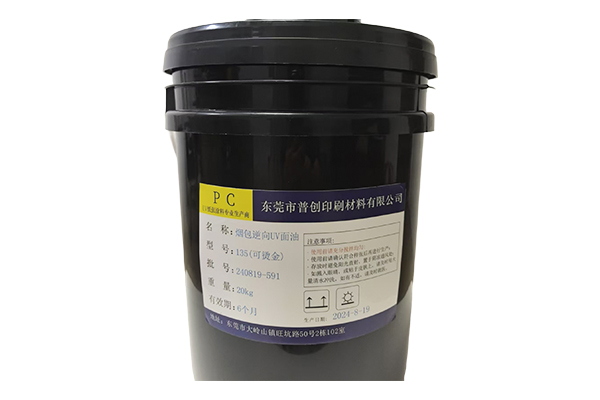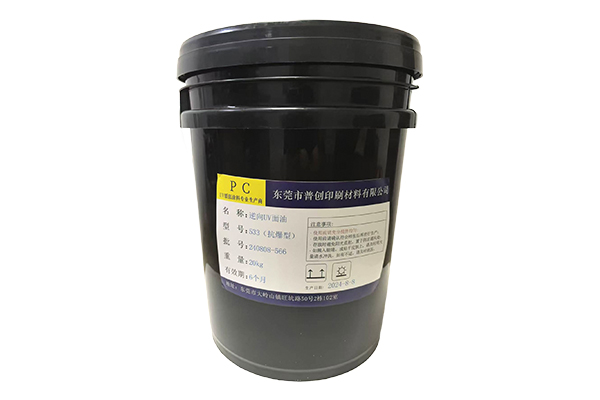Can the use of hot stamping reverse topcoat increase the barrier properties of paper packaging?
Release Time : 2025-06-19
In the modern packaging industry, paper products are widely used in many fields such as food, daily chemicals, medicine and electronic products due to their advantages such as environmental protection, recyclability and low cost. However, paper itself has certain hygroscopicity and air permeability, and has natural limitations when facing the penetration of grease, water or gas. Therefore, how to improve the barrier properties of paper packaging has become the focus of industry attention. In recent years, hot stamping reverse topcoat has gradually gained attention as a functional surface treatment material. While improving the appearance of packaging, it also shows the potential to enhance barrier properties.
Improve oil resistance and anti-penetration ability
Hot stamping reverse topcoat is usually composed of resin, wax and functional additives, and forms a dense film after coating and drying. This film not only gives the paper a higher gloss and touch, but also effectively reduces the penetration of external substances into the internal structure of the paper. Especially in the field of food packaging, such as fast food boxes, baking paper, and outer packaging of grease products, paper is easily contaminated by grease and becomes soft or even cracked. By using hot stamping reverse topcoat with oil-proof function, the paper's ability to resist oil penetration can be significantly improved without changing its original properties, thereby extending the service life of the packaging and improving product safety.
Improve moisture resistance and environmental adaptability
Paper products are prone to absorb water and deform in a humid environment, affecting printing quality and structural strength. Humidity control is particularly critical in rainy areas in the south or during cold chain transportation. Some high-performance hot stamping reverse topcoat formulas contain waterproof additives, such as silicones or fluorocarbons, which can reduce the surface tension of the paper surface and make it difficult for water molecules to penetrate into the fiber structure. Actual tests show that under the same humidity conditions, the moisture absorption rate of paper treated with reverse lacquer is reduced by more than 30% compared with untreated paper, thereby improving the overall stability of the packaging.
Impact on gas barrier properties
Although paper itself does not have good gas barrier capabilities, a certain degree of gas barrier effect can be achieved by reasonably selecting the components of hot stamping reverse topcoat. For example, some reverse topcoats containing nanofillers (such as silica, alumina) can form a "maze effect" in the coating, slowing down the diffusion rate of gases such as oxygen and carbon dioxide. This feature is particularly important for product packaging that needs to be preserved for a long time (such as dried fruits, medicines, tea, etc.), which helps to delay the oxidation and deterioration of the contents and maintain their original flavor and quality.
Synergize with composite processes to improve comprehensive performance
In actual production, hot stamping reverse topcoat is often not a single material, but as part of an overall packaging solution. It can be combined with other functional coatings or laminating processes to form a multi-level barrier system. For example, on a high-speed automatic packaging line, a layer of reverse topcoat with moisture-proof function is first applied, and then vacuum aluminum or PVDC (polyvinylidene chloride) is applied on it, which can not only greatly improve the barrier performance, but also take into account environmental protection requirements and avoid the recycling problems caused by the use of all-plastic composite structures.
In summary, hot stamping reverse topcoat not only bears the function of beautifying the appearance in paper product packaging, but also brings additional barrier properties to paper through its unique film-forming structure and formula design. From oil and moisture resistance to gas barrier, and then to synergy with various composite processes, it is gradually breaking through traditional cognition and becoming one of the important means to enhance the functionality of paper packaging.
Improve oil resistance and anti-penetration ability
Hot stamping reverse topcoat is usually composed of resin, wax and functional additives, and forms a dense film after coating and drying. This film not only gives the paper a higher gloss and touch, but also effectively reduces the penetration of external substances into the internal structure of the paper. Especially in the field of food packaging, such as fast food boxes, baking paper, and outer packaging of grease products, paper is easily contaminated by grease and becomes soft or even cracked. By using hot stamping reverse topcoat with oil-proof function, the paper's ability to resist oil penetration can be significantly improved without changing its original properties, thereby extending the service life of the packaging and improving product safety.
Improve moisture resistance and environmental adaptability
Paper products are prone to absorb water and deform in a humid environment, affecting printing quality and structural strength. Humidity control is particularly critical in rainy areas in the south or during cold chain transportation. Some high-performance hot stamping reverse topcoat formulas contain waterproof additives, such as silicones or fluorocarbons, which can reduce the surface tension of the paper surface and make it difficult for water molecules to penetrate into the fiber structure. Actual tests show that under the same humidity conditions, the moisture absorption rate of paper treated with reverse lacquer is reduced by more than 30% compared with untreated paper, thereby improving the overall stability of the packaging.
Impact on gas barrier properties
Although paper itself does not have good gas barrier capabilities, a certain degree of gas barrier effect can be achieved by reasonably selecting the components of hot stamping reverse topcoat. For example, some reverse topcoats containing nanofillers (such as silica, alumina) can form a "maze effect" in the coating, slowing down the diffusion rate of gases such as oxygen and carbon dioxide. This feature is particularly important for product packaging that needs to be preserved for a long time (such as dried fruits, medicines, tea, etc.), which helps to delay the oxidation and deterioration of the contents and maintain their original flavor and quality.
Synergize with composite processes to improve comprehensive performance
In actual production, hot stamping reverse topcoat is often not a single material, but as part of an overall packaging solution. It can be combined with other functional coatings or laminating processes to form a multi-level barrier system. For example, on a high-speed automatic packaging line, a layer of reverse topcoat with moisture-proof function is first applied, and then vacuum aluminum or PVDC (polyvinylidene chloride) is applied on it, which can not only greatly improve the barrier performance, but also take into account environmental protection requirements and avoid the recycling problems caused by the use of all-plastic composite structures.
In summary, hot stamping reverse topcoat not only bears the function of beautifying the appearance in paper product packaging, but also brings additional barrier properties to paper through its unique film-forming structure and formula design. From oil and moisture resistance to gas barrier, and then to synergy with various composite processes, it is gradually breaking through traditional cognition and becoming one of the important means to enhance the functionality of paper packaging.






